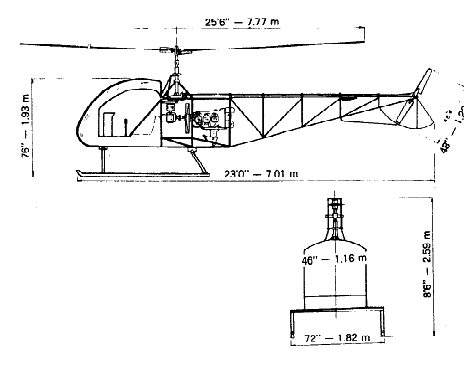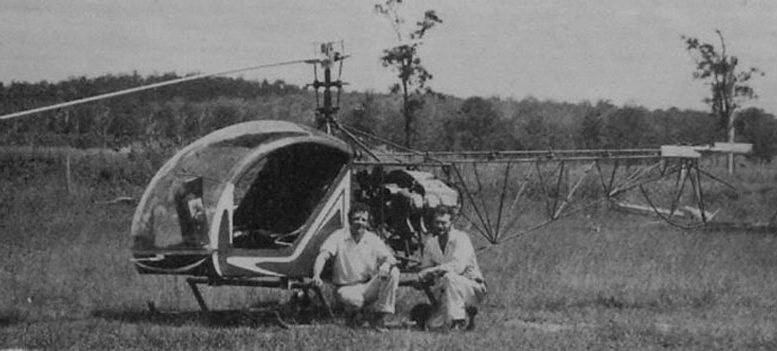Australia’s Phillips Helicopter – The Phillicopter
PHILLICOPTER HELICOPTER DESCRIPTION
The Phillicopter is a robust two place helicopter designed for hard work. Whilst it has been primarily designed for the livestock and agricultural industries, it will also appeal to a much wider market as its performance is at least equal to that of its competitors but its purchase price is significantly lower and parts less expensive.
The Phillicopter has been given the status of a MAJOR PROJECT by, CASA (Australia). It is designed to FAR27, ‘Airworthiness Standards: Normal Category Rotorcraft and has undergone rigorous testing and supervision by CASA.
It is NOT an “Experimental Aircraft” but may be purchased in that category if desired, with provision for Type Approval upgrade. Component parts have creditable hours and are locally made to approved drawings and specifications.
The design of the Phillicopter is based on tried and proven helicopter engineering principles to minimise production and maintenance costs. It incorporates readily available commercial aviation approved components for ease and simplicity of maintenance. The helicopter’s primary structure comprises a skeletal air frame of chrome molybdenum aircraft steel tubing manufactured in two sections:
-
A forward fuselage consisting of engine, transmission bay, main rotor support system, cabin and appointments, controls and instrumentation. The main rotor drive and clutch gear transmission modules are incorporated in the air frame enabling easy access to all control rods, engine and transmission. The foam-filled metal rotor blades are tuned and balanced to minimise excitable vibrations. Low maintenance flexible couplings have been used for all primary and secondary drive systems.
-
The well-appointed aluminium and Perspex clad cabin has side by side seating with conventional dual controls and adjustable rudder pedals. The collective pitch twist throttle with concentric starter button is of normal configuration. Arc of vision from the cabin is excellent and the instruments are set out to provide ease of scanning by the pilot. Two easily-removable cabin doors provide access and the skid-type undercarriage allows ground handling wheels to be attached if required.
-
The aft fuselage is bolted to the forward air frame and supports the tail rotor drive that’s inclusive of gear box, control cables and stabilisers. A range of easily fitted optional equipment including night lights, cabin heater, rate of climb indicator, clock, cargo hook, spray boom, spray tanks, cargo racks and auxiliary fuel tank is available.
PHILLICOPTER HELICOPTER AFTER SALES SERVICE (historical – 1975)
A comprehensive list of parts provides adequate provision for replacement parts when required at short notice along with technical advice. (Ed. as far as we know, this helicopter is no longer supported or in production and considered obsolete)
| PHILLICOPTER HELICOPTER SPECIFICATIONS | |
|---|---|
| Main rotor diameter | 7.77 m |
| Tail rotor diameter | 1.22 m |
| Length overall – rotors fore and aft | 8.79 m |
| Fuselage length | 6.65 m |
| Height overall | 2.54 m |
| Cabin length | 1.63 m |
| Empty weight | 476 kg |
| Maximum take-off weight (MTOW) | 748 kg |
| Maximum level speed | 145 km/h |
| Maximum cruising speed | 137 km/h |
| Economy cruising speed | 112 km/h |
| Maximum rate of climb at sea level | 365 m/min |
| Vertical rate of climb at sea level | 91 m/min |
| Service ceiling | 4880 m |
| Hovering ceiling in ground effect (HIGE) | 2440 m |
| Hovering ceiling out of ground effect | 1830 m |
| Range with max fuel | 370 km |
Mr Phillips, assisted by Mr P. Gerakiteys, designed and built a prototype two-seat helicopter known as the Phillicopter Mk 1. Design work began in 1962, construction started in 1967, and the prototype flew for the first time in 1971. Flight trials were continuing in early 1975. Orders for the Phillicopter have been held in abeyance pending the completion of these trials.
PHILLICOPTER HELICOPTER DETAILS
▣ TYPE: Two-seat light helicopter.
▣ ROTOR SYSTEM: Two-blade main and tail rotors. Main rotor blades, of NACA 0012 section and fully-extruded hollow-section construction, are attached to hub by solid grips. Fixed tab on each trailing-edge. Tail rotor blade construction similar to main rotor blades.
▣ ROTOR DRIVE: Via three gearboxes: one transfer box, one reduction box (Commuter/Safari helicopter gearbox) and one tail rotor box (also Commuter/Safari helicopter gearbox). Main rotor/engine rpm ratio 1:5.66 – tail rotor/engine rpm ratio 1:1.
▣ FUSELAGE: Tubular steel airframe, with aluminium and glass-fibre covering.
▣ TAIL UNIT: Tubular steel open space-frame. Tailplane incidence adjustable manually on ground.
▣ LANDING GEAR: Tubular skid type. Shock-absorption through bending and torsion of cross-members. Ground handling wheels. Float gear available optionally.
▣ POWER PLANT: One 145hp Rolls-Royce Continental O-200-C four-cylinder horizontally-opposed air-cooled engine. Single fuel tank, capacity 82 litres. Oil capacity 5.7 litres.
▣ ACCOMODATION: Side-by-side seating for pilot and one passenger. Door on each side of cabin. Accommodation ventilated.
▣ SYSTEMS AND EQUIPMENT: Battery for electrical power. Radio fitted.
For reasons unknown, relatives of the Phillicopters designer have not approved public display of their Phillicopter helicopter flying video…makes you wonder?
PHILLICOPTER HELICOPTER KIT INFORMATION

Australian Phillicopter two seat helicopter
In kit form you will receive:
-
a) Pre Flight Manual
-
b) Abridged Flight Manual
-
c) Maintenance Manual
-
d) Construction Manual
-
e) Assembly drawings
-
Basic Airframe Kit. Comprising all necessary aircraft tubing to build and complete the forward fuselage and aft fuselage, undercarriage and shock mounts. Tail rotor drive shaft. The tubing will need to be fitted and welded.
-
Control system including castings, taper pins, control rods, rod ends, pulleys, cable: and associated hardware.
-
Material for engine cowling and firewall.
-
Engine cooling fan, engine drive shaft and coupling to primary gear box along with spacers.
-
Centrifugal clutch assembly, sprag clutch and spacers.
-
Primary gearbox assembled along with anchorage frame materials.
-
Main rotor gearbox assembly including mast head, fitted swash plate assembly ready for installation. Scissors and associated hardware.
-
Main rotor spindle and perch including gimbal and bearings. Blade grips with bearings control horns. Matched main rotor blades.
-
Tail rotor gearbox assembled ready for installation, tail shaft bearings and couplings.
-
Tail rotor control system, tail rotor spindle and hubs, including bearings. Matched tail rotor blades and pitch change castings.
-
Horizontal stabiliser materials. Vertical stabiliser materials.
-
Fuel tank, fuel pump, primer kit and fuel line materials
-
Cabin Kit includes:- canopy, enclosure materials adjustable bucket seats. Fibreglass top and nose pod. Seat belts.
-
Instrument panel along with instrument group including altimeter, air speed indicator, manifold pressure, oil pressure, oil temperature, compass, magneto switch, master switch, fuel gauge, ammeter, tachometer for engine and rotor RPM.
-
Wiring materials kit contains all wiring materials. Ancillary hardware and fastenings.
PHILLICOPTER HELICOPTER OPTIONS
-
Ground handling wheels
-
Finished or tack welded forward airframe
-
Finished or tack welded tail boom
-
Doors
Engine choice included is 180 HP, Lycoming re-manufactured / good as new, 2000 hrs currently priced at $36,000 (1975) Australian dollars. Alternatively Jabiru 180 HP could be substituted.
INNOVATIONS USED IN CONSTRUCTION OF THE PHILLICOPTER HELICOPTER
The Phillicopter helicopter is made in modules which make it easy to assemble and maintain.
-
a. Forward and aft airframe using high tech materials and welding techniques.
-
b. Rear airframe simply connected to engine bay.
-
c. Tail rotor system able to be bench assembled and tested.
-
d. Main rotor system able to be bench assembled and balanced.
-
e. Tailored main and rotor gear boxes using lightweight materials.
-
f. Tailored primary gear box transmitting horizontal to vertical power.
-
g. Tailored light weight centrifugal clutch incorporating over-run.
-
h. Engine and gear box coding systems simplified using readily available parts.
Items e, f and g bench assembled for easy installation and disassembly.
Main rotor and tail rotor blades use high tech aluminium components of high dimensional accuracy along with advanced technology in bonding component parts to each other. Blades are high inertia enabling soft autorotative landings and prolonged time response as a safety margin for the pilot.
NOTE: This is not a characteristic of the nearest competitor whose rotor RPM decay quite rapidly with little time for the pilot to react in the event of engine failure.
The airframe is more robust than other comparable helicopters and quite capable of providing a high margin of safety in operations such as mustering and training.
For agricultural purposes including crop spraying training mustering it may be used for other tasks such as surveillance, ship to shore, general commuting, forestry, pipeline and transmission line inspection.
| PHILLICOPTER HELICOPTER RECOMMENDED OVERHAUL & INSPECTION | ||||
|---|---|---|---|---|
| ITEM | INSPECT | TYPE | OVERHAUL | RETIRE |
| * Primary gearbox | 100 hrs | As per manual | ||
| * Main rotor gearbox | 100 hrs | As per manual | 2,000 hrs | |
| * Tail rotor gearbox | 100 hrs | As per manual | 2,000 hrs | |
| Main rotor grips | 100 hrs | Dye pen | 4,000 hrs | |
| Main rotor spindle | 100 hrs | Magnetic particle | 2,000 hrs | |
| Main rotor control horn | 100 hrs | Dye pen | ||
| Main rotor blades | 100 hrs | Dye pen | 2,000 hrs | |
| Main rotor thrust bearing | 100 hrs | Visual | 300 hrs | |
| Swash plate bearing | 100 hrs | Visual | 500 hrs | |
| Tail rotor blades | 100 hrs | Visual | 2,000 hrs | |
| Tail rotor grips | 100 hrs | Dye pen | 5,000hrs | |
| Tail rotor spindle | 100 hrs | Magnetic particle | 2,000 hrs | |
| Tail rotor thrust bearing | 300 hrs | |||
| Tail rotor pitch change bearings | 100 hrs | Visual | 300 hrs | |
| Tail rotor rod ends | 100 hrs | Visual | 300 hrs | |
| Clutch assembly | 100 hrs | Visual | ||
| Tail Rotor bearing | 100 hrs | Visual | 300 hrs | |
| Tail Rotor couplings | 100 hrs | Visual | As required | |
| Engine coupling | Infinite | Life | ||
NOTE: * Gears & pinions & bearings.
PLEASE NOTE: The current status of this helicopter is unknown, attempts at contact have been unresponsive – this helicopter does not seem to be supported. There are plenty of better options on the current market.







Be the first to comment on "Australian Phillips Helicopter – The Phillicopter"